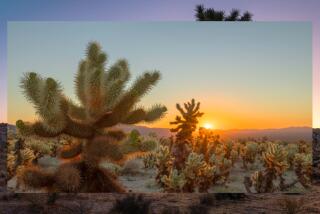Trailblazing trek on blazing Sahara trails
- Share via
Scientists think the Sahara Desert has been hot and dry for the last 3,000 years. I can’t speak to that, but I can attest to its profound hostility to humankind for four days last month on a trek in southwest Libya with Mountain Travel Sobek, an American travel company.
The debut trip was billed as an “exploratory adventure.” Ten American travelers — some experienced outdoors enthusiasts who had “Lawrence of Arabia” fantasies, others ordinary, nonathletic tourists looking for exotic sights — joined a trip that traveled 700 miles south from Tripoli to the oasis hamlet of Ghat, then into the Acacus Mountains, where ancient rock art in secret places suggests the Sahara was once temperate enough to succor giraffes, buffalo and man.
With us came Bastien Stieltjes and Ludovic Bousquet, two tough, sun-blasted guides from Hommes et Montagnes, a French company with 30 years of experience in tourist treks to the arid no-man’s-lands of Ethiopia, Mali, Niger, Tunisia and Chad. They were supported by a host of indigenous Sahara Tuareg cooks, porters and camel herders. There was also strong, silent Mabrouk, a Libyan “security agent” who stuck with us through the worst, though he generally looked as though he’d rather be drinking mint tea in Tripoli.
People do bizarre things — clawing their way up mountains, thrashing through jungles, shooting waterfalls in barrels — for a chance to say they were first. In this regard, Mountain Travel Sobek, or MTS, has quite a track record, including the first commercial summit of 22,835-foot Aconcagua, on the border between Chile and Argentina, in 1972; the first cross-country ski tour to the South Pole, in 1989; and first descents of Pakistan’s Kunar and Swat rivers, in 1993.
I can say I was with the first American group to go to the Libyan Sahara since U.S. travel sanctions were lifted in March. MTS had to do it in April, because several other companies had scheduled trips to Libya, many of them for fall.
The most inhospitable season for trekking in the Sahara is May to October, but even by the end of April, the great 3.5 million-square-mile desert that stretches across northern Africa can get a little toasty. As a result, the trip was more agony than ecstasy.
It started out well enough. We flew on Libyan Arab Airlines from Tripoli to Ghat, which sits on a desert flat and looks a little as I imagine Palm Springs did before sprinklers. It has an Italian colonial fort and a Gaudí-esque old medina, built of sand and dung, mostly melted away and abandoned after a devastating freak flood in the 1960s.
From there, we took Toyota Land Cruisers out of town. These were like any SUVs on L.A. freeways, except for the goatskin water vessels strapped to the sides. It was hot — 95 degrees, I’d guess — but as an enthusiast of America’s desert Southwest, I know discomfort is the price of admission.
Our first night’s camp was on the flank of a huge sand dune, where we frolicked with the enthusiasm of Florida kids on an Alaskan glacier.
Sitting on a mat, we ate spicy soup, followed by couscous, rice or pasta covered with vegetable and goat stew, prepared by Kader, our Tuareg cook. Then there were the traditional three glasses of tea: the first “bitter like life the second strong like love, the third sweet like death,” as 20th century Sahara desert naturalist Théodore Monod wrote. Abandoning the vehicles, we unrolled our sleeping bags and entrusted ourselves to a herd of kind and graceful, one-humped Tuareg camels, which occasionally bellowed late at night.
*
Good humor amid the heat
The first day’s eight-mile trek took us across a flat scattered with fossils and arrowheads, then over a pass that gave us views of a seemingly endless fretwork of charcoal-colored mountains, lapped by alluvial fans of sand. After climbing another row of dunes and crossing another flat, we stopped for lunch under a lone acacia tree, where we melted like spent candles. Kader made us a salad Niçoise, and Bastien broke out cheese and pâté, but I had little appetite. It was 102 degrees.We waited until 4 p.m. to get going again, vainly hoping to avoid the cruelest heat of the day. By the time we pitched camp under another solitary acacia in a wadi, or canyon, we were exhausted. One member of the group had an eye infection and seemed close to heat exhaustion; another had stomach pains, caused, he soon realized, by kidney stones.
But our humor remained good, especially when we learned we had only four hours to hike the next morning.
As the day faded, John Canning of Seattle hooked up his solar-charged laptop, filed the pictures he’d taken with his digital camera that day and shared them with the Tuareg, a moment of pure cross-cultural magic.
Alas, four hours of hiking by Tuareg estimation is 7 1/2 for soft Americans (about seven miles). There were some dim scratches of rock art and bizarrely shaped mountains to see along the way. Mostly, I socialized with Bastien, a tall drink of tea who looked a little like Johnny Depp and read philosophy during rest stops. I also had the first of several puzzling conversations in French with Mama, our Tuareg guide. (Most of his fellows spoke only their native language, Tamashek.) He told me he was 41 and unmarried but that he wanted a woman; later he said, less subtly, that he wanted a woman that night. Those times when I flagged, he put me on a camel, where I sat like a pasha, my legs crossed over the beast’s neck.
By the time we camped under a rock overhang, I was thinking I might be able to complete the trek, despite the long, hot days in the inhospitable desert. Others, though, were holding private discussions with MTS trip leader Richard Bangs. Late that afternoon, he addressed the group, offering us the option of aborting the trip. Six of us decided to leave, including the two clearly indisposed members of the group. Bangs, who handled the situation calmly and thoughtfully, said he would stay, allowing three others to carry on.
The vehicles couldn’t get to our campsite, though, so we hiked the next morning to a more accessible spot, another longer-than-predicted slog ending in another interminable afternoon on the mats, all of us supine, singing pop hits from the 1960s.
At 3:30 p.m. Bangs put his thermometer in the sun-cooked sand. It registered 132.8 degrees.
Finally, the Land Cruisers crested a nearby dune, taking those who didn’t want to walk two more hours to our final campsite in a starkly beautiful countryside surrounded by rock arches and sculpted hoodoos. The vehicles had brought more water, giving us enough for sponge baths from tin bowls. The night was cool.
The next morning, we gave those who were going on our private stashes of candy and clean socks, then headed out of the desert — a 200-mile trip that took 9 1/2 hours, with stops for rock art viewing. At one point, I saw a four-horse chariot scratched on the side of a boulder, bespeaking the mysterious desert empire of the Garamantes, who ruled southwest Libya for 1,000 years until 19 BC, when the Romans arrived.
That night, there were the non-flushing toilets, trickling showers and cockroach-y rooms of the Hotel Ghat to enjoy along with a good deal of post-trip assessment. Ludovic, who was with us, said Hommes et Montagnes rated our trek easy, except for the heat. A couple who had been on many MTS expeditions said ours differed from theirs in its lack of a latrine tent and other camping amenities.
For the members of the trip who went on, things only got more miserable. They endured an eight-hour sandstorm and suffered six breakdowns — mechanical, not mental — on the ride out. Bangs, who accepted it all without complaint, later said, “You go. You try.”
I expect there will be modifications when MTS repeats the trip in the fall, meaning those who take it may be better able to enjoy the once-in-a-lifetime experience of trekking through the Libyan Sahara.
But don’t forget. We were first.
More to Read
Sign up for The Wild
We’ll help you find the best places to hike, bike and run, as well as the perfect silent spots for meditation and yoga.
You may occasionally receive promotional content from the Los Angeles Times.






